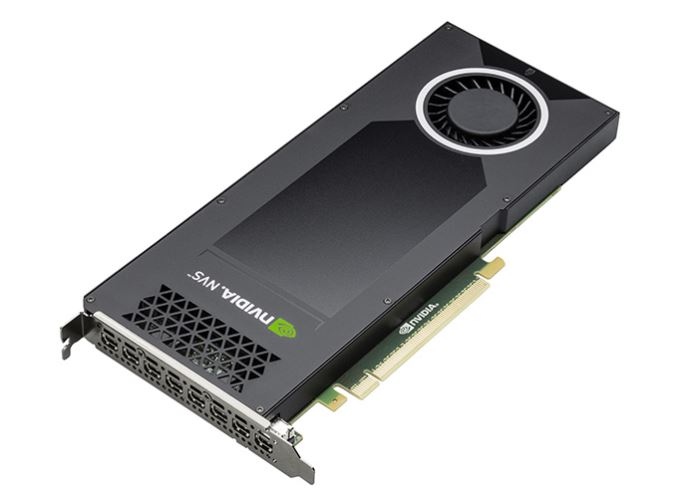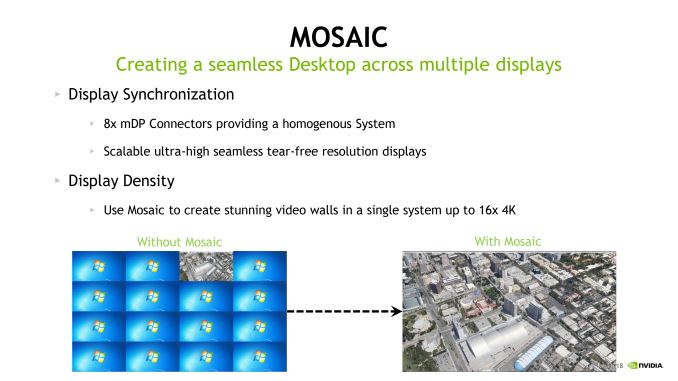NVIDIA Launches NVS 810 Digital Signage Video Card
by Daniel Williams on November 4, 2015 5:30 PM EST
Entry level multi-display workstations aren’t a market that gets anywhere near the amount of attention that many of us are used to seeing in other markets. Never the less it is a market that definitely needs something catering to its needs, be it large format signage, financial trading, or any other area where a large number of displays are needed but not a large amount of horsepower to push them.
To that end, today NVIDIA is launching a new entry into their venerable NVS multi-display lineup, the NVS 810. Seeing as this market segment doesn't see updates very often this is the first and possibly only Maxwell based card to be released in this sector. This card is based around a pair of GM107 GPUs on a single board, allowing NVIDIA to outfit the NVS 810 with 8 mini-DP 1.2 ports on a single-wide PCIe card.
For the NVS 810’s hardware, under the hood we are looking at a pair of partially enabled GM107 GPUs with 512 of 640 CUDA cores enabled, for a total of 1024 CUDA cores. This is paired up with 2GB of VRAM per GPU for a total of 4GB, and though NVIDIA doesn’t specify the memory type it’s safe to assume it’s DDR3. Otherwise NVIDIA is targeting a relatively low power profile here – just 68W total board power – with the lower board power helping with GPU density and makes stuffing the maximum of four of these cards into a single machine at once a much more civil affair.
| NVIDIA NVS 810 Specfications | ||
| NVS 810 | ||
| CUDA Cores | 2 x 512 (1024) | |
| Memory | 2 x 2GB (4GB) | |
| Display Connectors | 8x Mini DisplayPort (8x 4096x2160 @ 30Hz or 4x 4096x2160 @ 60Hz) |
|
| Max Configuration (Win10/Linux) |
4 Boards, 32 Displays | |
| Total Board Power | 68W | |
| Length | 9.5" | |
| Width | Single Wide (4.4") | |
| Cooling | Active | |
| MSRP | $650-$750 | |
Speaking of stuffing cards in a machine, while I imagine that real world implementations of this may be rare, where I notice that this solution gets immensely crazy is the sheer number of mDP ports on hand coupled with the ability to fit four in one machine. Coupled with NVIDIA’s Mosaic display stitching and synchronization software, it’s possible to use a pair of NVS 810s together to drive up to 16 4K displays as if they are one massive display. Regardless of the rarity of such an implementation the idea that one could build a micro-ATX computer that could drive what’s functionally a 137MP display is a very impressive thought indeed.
Wrapping things up, NVIDIA tells us that the NVS 810 is expected to have a street price in the $650-$750 range. Overall the company is pitching the NVS 810 as a high density, low total cost solution to situations requiring a large number of high pixel count displays. As a result NVIDIA is chasing a very specific market with the board, but for those with such needs the NVS 810 brings quite a bit to the table.











38 Comments
View All Comments
HollyDOL - Thursday, November 5, 2015 - link
Thinking about it, what else than adobe circus can you feed there... Running 137Mpx video is prolly out of question, not sure if these cards can handle that, let alone where to get one, buying 4k and then upscaling sounds weird too... so in the end I guess you'll be looking for a vector source.This imho needs more testing...
xype - Thursday, November 5, 2015 - link
Can radeons do something like Mosaic? Because the "Make huge desktop and automagically span it across displays as one" is what the selling point is here. There’s plenty of big "display wall" use cases where something like that would make setting everything up much easier than syncing the output of different cards together properly. And for those scenarios, anything under $1000 is a steal.nightbringer57 - Thursday, November 5, 2015 - link
Eyefinity does that, AFAIK.In fact, AMD was first on the "many displays on one card" selling point, if I remember correctly.
Dribble - Thursday, November 5, 2015 - link
In the consumer market, not professional like this. Matrox was doing this sort of thing many many years earlier. Nvidia too with their Quadro cards. AMD gets the praise for making it standard outside of the fancy pro-card market.mickulty - Thursday, November 5, 2015 - link
Yes, it's called eyefinity and has existed for about 6 years at this point. As far as I can tell the maximum number/size supported by GCN card is 6 4K displays but idk if you can extend it further with more cards.Flunk - Thursday, November 5, 2015 - link
Yes, you can have multiple cards. If my Radeons are not in Crossfire they support 12 monitors at once, in crossfire it's only 6.Klimax - Thursday, November 5, 2015 - link
Where can I get new 6,5USD Radeon?Morawka - Thursday, November 5, 2015 - link
http://www.newegg.com/Product/Product.aspx?Item=N8...Morawka - Thursday, November 5, 2015 - link
Just google 6 mini dp radeon and take your pick.. There are tons of them.. and no they dont have to buy the firepro cards, mosiac is a driver feature (software) not hardware implementation on either GPU maker.http://www.club-3d.com/index.php/products/reader.e...
Kevin G - Thursday, November 5, 2015 - link
This card only costs a few hundred more than the cheapest FirePro with six miniDP connectors. Considering the difference in power consumption (no 6 pin PCIe necessary!) and extra connectors, the price premium is justified.The other interesting thing is that Mosaic appears to work across both multiple GPUs (the NVS 810 has two) and even across multiple cards. While expected for the NVS 810, this software also works with Quadros for those looking for bit more pixel pushing power to go along with the displays.